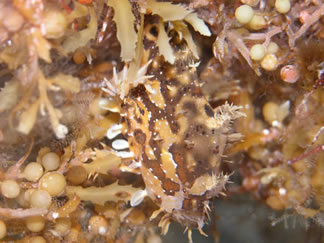Sargasso Sea
These lines of Sargassum can stretch for miles along the surface. The clumps of floating algae are often concentrated by the strong winds and wave action associated with the Gulf Stream.
During Christopher Columbus's voyage of discovery across the Atlantic, he was amazed to find floating mass of seaweed as far east as the Azores. It looked like a carpet of little yellow grapes so they called it sargazo (a generic name in Spanish for seaweeds with a brown colour and with an obvious stalk and root; the Sargasso Sea is "El mar de los Sargazos"). Sargassum is a brown algae and the ‘grapes’ are the air bladders, which keep it afloat. It may look like the attached marine plants found in coastal waters, but it’s found in the middle of the North Atlantic Gyre. The area, of about 2 million square miles, is known as the Sargasso Sea.
The Sargasso Sea seems to be be largely composed of two species: Sargassum natans and Sargassum fluitans, which probably originate in the Caribbean, but the floating masses seem to propagate themselves by framentation. Seaweed cells are totipotent and any fragment of a brown alga can regenerate an entirely functioning plant. The cover of Sargassum in the Sargasso Sea is not complete: there are generally iwdely spaced rafts of drifting plants throughout the area, and in some aprts of the Sea very few plants may be present.
At the centre of the ocean gyres the water is clear blue and there’s nothing to bring nutrients to the surface, so how does Sargassum survive? A possible answer is that as the Gulf Stream meanders, little rings of nutrient-rich coastal water break away and drift into the Sargasso Sea, supporting the algal growth.
 Sargassum provides a habitat for many creatures more often found near coasts, including shrimps, crabs, worms and fish, so it’s no wonder that Columbus thought his ship must be nearing an island. Some life-forms have evolved along with the weed and taken on its colour for camouflage. The Sargassum fish (Histrio histrio right) uses its fins to crawl through the plant forest.
Sargassum provides a habitat for many creatures more often found near coasts, including shrimps, crabs, worms and fish, so it’s no wonder that Columbus thought his ship must be nearing an island. Some life-forms have evolved along with the weed and taken on its colour for camouflage. The Sargassum fish (Histrio histrio right) uses its fins to crawl through the plant forest.
Flotsam and jetsam can circuit the north Atlantic for a long time, but eventually it collects in the Sargasso Sea where it provides shelter for juvenile fish such as tuna that use it to hide from sea birds. Natural and man-made debris is used in this way in many of the world’s oceans and it follows that where you find small fish you find predators. Wahoos and dorado have developed a strong interest in floating flotsam.






